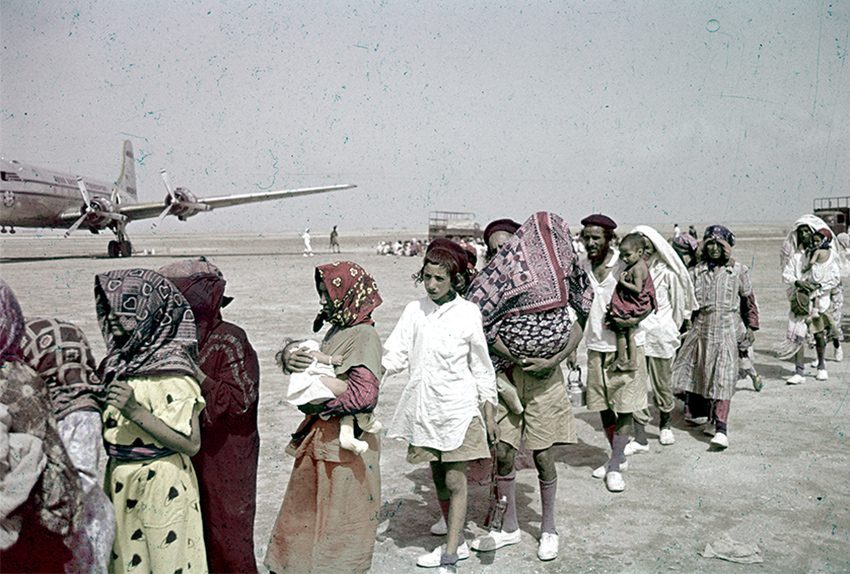- Pulished by
-
JDC at
-
October 11, 2022

Chances are you might have heard of the modern exodus of the Jews of Ethiopia during Operations Moses and Solomon, which together airlifted some 22,000 Ethiopian Jews to Israel over 1984-1985, which was an astonishing feat for its time.
However, there also happens to be another mass evacuation of Jews that occurred some 35 years before.
The dramatic exodus in question is the post WW2 evacuation (referred to as Operation Magic Carpet) of over 48,000 Jews from Yemen from 1949-1950.
So why was this evacuation so significant?
For Yemen Jews, life in the 20th century was for the most part, desolate. They were categorised as second-class citizens, having gradually seen their rights and autonomy crumble over generations.
In fact, life as a Jew in Yemen had been like this for a while.
By multiple accounts, it is believed that the Jewish community in Yemen had been established since the turn of the second century. Yemenite Jews have their own customs and practice of Judaism dating back to this period and are in that sense unlike Ashkenazi, Sephardi, and other Jewish groups.
One Yemenite Jewish legend tells that Jews came to the Arab Peninsula during the reign of King Solomon, having sent Jewish merchants to Yemen to prospect for gold and silver. A southern Yemenite Jewish (Habban) tradition details their descendants belonging to a brigade sent by Herod the Great to assist the Roman legions fighting in the region.
Life until the arrival of Shiite-Zaydi clan in the early 10th century was relatively peaceful for Yemenite Jews, enjoying freedom of religion on the condition of paying tax and little to no persecution from the tolerant Sunni Muslims in power at the time.
Unfortunately for the Jewish community, after taking power, the Zaydi rule stretched for over 1,000 years and marked the beginning of a long history marked by persecution, oppression and subjugation by the population and the state.
Cruel decrees from the state included second class citizen status, inability to touch a Muslim’s food and banned from defending themselves if attacked by Muslims.
One of the more notable of these suppressive motions was the Orphan’s Decree.
This stated that if a Jewish youth’s father died, the child was to be taken by the state and then converted to Islam, by force. During the Ottoman rule, the law was swept to the side, largely ignored, and rarely enforced.
A major catalyst for the evacuation of Yemenite Jews was the enforcement of the Orphan’s Decree by the hand of Imam Yahya.
Jewish orphans were abducted from the community, with little opportunity for release. The families and communities rallied for solutions and the return of their youth, including moving them to large cities and hiding them with other Jews, or marrying them off to give them the status as an adult.
As this cruel law was strictly enforced, the Jews of Yemen began to emigrate to what was then Palestine.
In 1947 following the partition vote in which the UN voted to split Palestine giving half to Arabs and half to Jews, Arab Muslims in Yemen caused a riot, killing 82 Jews in Aden and destroying hundreds of Jewish homes, while in the process torching the Jewish quarter.
This traumatic period compounded with a chain of events, notably gradually rising tensions between the Jewish and Islamic community (especially after the establishment of the state of Israel in 1948) led to the emigration of virtually the entire Yemenite Jewish community between 1949 and September 1950.
As Egypt had closed the Suez Canal to the Yemenite Jews, they had little choice but to travel by air to Israel.
Britain agreed to establish an air transit camp in the Crown Colony of Aden where Yemenite Jews could embark on their airlift to Israel.
Titled Operation Magic Carpet, the JDC planned, organised and financed the passage of 48,000 Yemenite Jews from Aden to Israel.
Close to 450 flights were chartered in collaboration with Alaska Airlines, airlifting the entire Jewish community from Yemen to Israel. Yemenite Jews travelled hundreds of kilometres crossing deserts, mountains, and borders, often on foot to arrive in Aden from where they were taken to Israel.
Today, the majority of Yemenite Jews live in Israel and are all that remain of the 2000-year legacy of Yemenite Jewry. It is estimated there is one Jew remaining in Yemen, with allegations that there may be more practicing in secret.
-
JDC
-
February 08, 2023
JDC is in Turkey Helping Provide Relief and Recovery After Devasting Earthquakes
-
Web Development
-
February 06, 2023
One Refugee Worker In Moldova Discusses Her Lifesaving Work With Jewish Refugees
Get updates from The Joint & JDC
It’s the easiest way to keep up to date with all our latest news, events and fundraising activities.
© 2024 The Joint Australia | Partner of American Jewish Joint Distribution Committee, Inc

